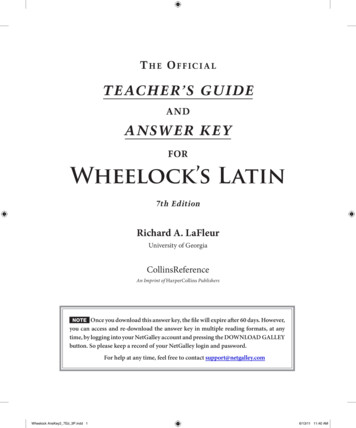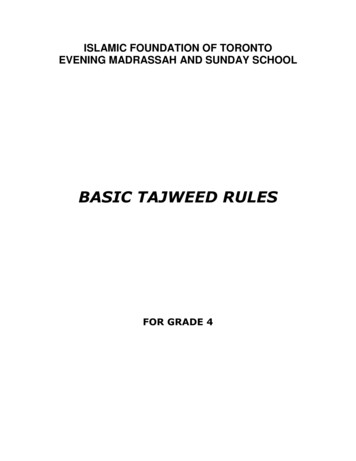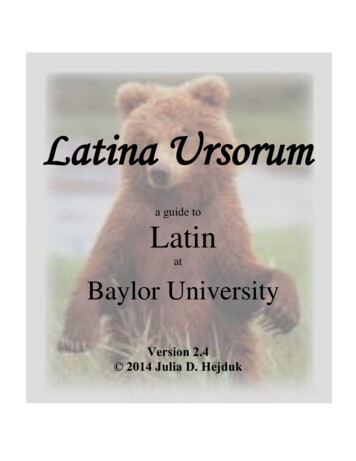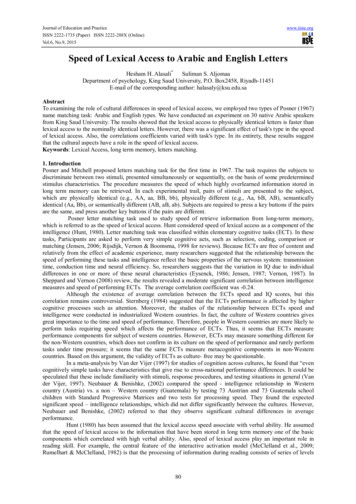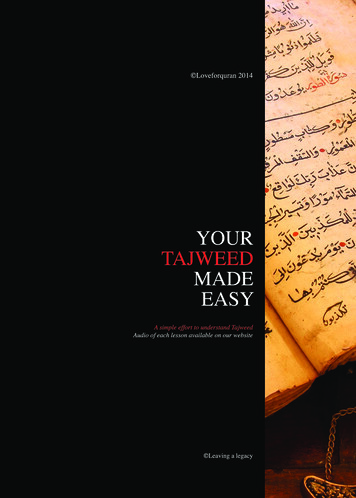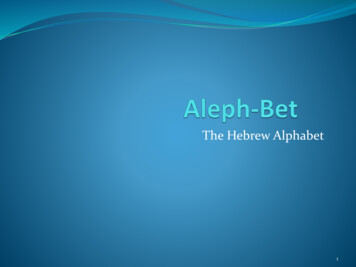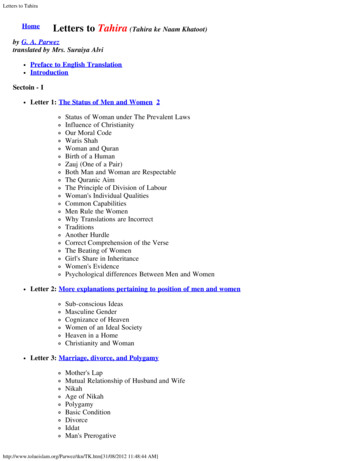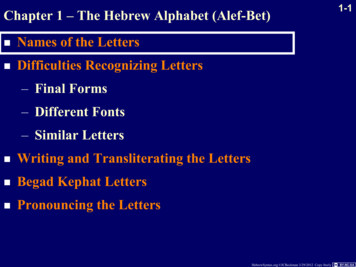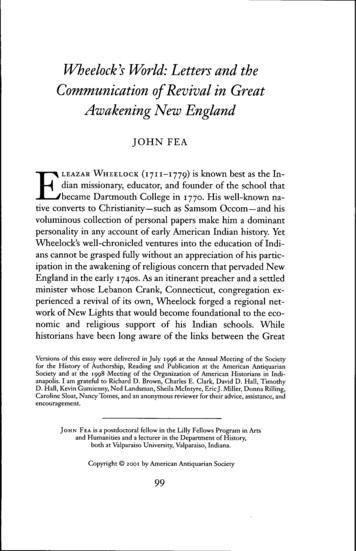
Transcription
Wheelock s World: Letters and theCommunication of Revival in GreatAwakening New EnglandJOHN FEALEAZAR WHEELOCK (1711-1779) is known best as the Indian missionary, educator, and foimder of the school thatbecame Dananouth College in 1770. His well-known native converts to Christianity—such as Samsom Occom—and hisvoluminous collection of personal papers make him a dominantpersonality in any account of early American Indian history. YetWheelock's well-chronicled ventures into the education of Indians cannot be grasped fully without an appreciation of his participation in the awakening of reHgious concern that pervaded NewEngland in the early 1740s. As an itinerant preacher and a settledminister whose Lebanon Crank, Connecticut, congregation experienced a revival of its own, Wheelock forged a regional network of New Lights that would become foundational to the economic and religious support of his Indian schools. Whilehistorians have been long aware of the links between the GreatEVersions of this essay were delivered in July 1996 at the Annual Meeting of the Societyfor the History of Authorship, Reading and Publication at the American AntiquarianSociety and at the 1998 Meeting of the Organization of American Historians in Indianapolis. I am grateful to Richard D. Brown, Charles E. Clark, David D. Hall, TimothyD. Hall, Kevin Gumienny, Ned Landsman, Sheila Mclntyre, Eric J. Miller, Donna Rilling,Caroline Sloat, Nancy Tomes, and an anonymous reviewer for their advice, assistance, andencouragement.JOHN EEA is a postdoctoral fellow in the Lilly Fellows Program in Artsand Humanities and a lecturer in the Department of History,both at Valparaiso University, Valparaiso, Indiana.Copyright 2001 by American Antiquarian Society99
iooAmerican Antiquarian SocietyAwakening and colonial Indian missions, they have generallyignored, or simply brushed over, Wheelock's role in the NewEngland religious world prior to 1745. Such an approach neglectsthe deeply embedded evangelical roots of Wheelock's missionarycareer.'AVheelock was a prolific religious communicator—a 'chief intelligencer of revival news.' It was in this capacity that he madehis greatest contribudon to the spread and preservadon of theGreat Awakening in New England. Wheelock sent and receivednews of local awakenings occurring throughout the countrysidewith remarkable frequency. Ministers and lay people from allparts of the region wrote to the Connecdcut clergyman to describe their local revivals, invite him to preach, request spiritualcounsel, or discuss religious polidcs. William Gaylord, Congregadonal minister at Norwalk, Connecdcut, began a 1740 letter toWheelock by remarking that 'Since we can see one another butseldom, I am glad to do my part toward supplying . . . a frequentexchange of letters.' Numerous New Englanders during theGreat Awakening could echo the words of Eldad Tupper of Sandwich, Massachusetts, when he thanked Wheelock for 'the thingsyou acquaint me with being Glorious things Concerning the cityofGod.'3This essay thus is concerned not with Wheelock the Indianschool principal, but with Wheelock the Great Awakening letterwriter. While scholarship on religious communicadon in early1. Biographical accounts of Wheelock include James Dow McCallum, Eleazar Wheelock(Hanover, N.H.: Dartmouth College Publications, 1939; reprint New York: Amo Press,1969); Frederick Chase, A History ofDartmouth College and the Town ofHanover, New Hampshire (Brattleboro, Vt.: Vermont Publishing Co., 1928), James Axtell, 'Mr. Wheelock's Little Red School,' in The European and the Indian: Essays in the Ethnohistory of Colonial A?nerica (New York: Oxford University Press, 1981), 87—109; Axtell, The Invasion Within: TheContest of Cultures in Colonial North America (New York: Oxford University Press, 1985),204-15. Chase, A History of Dartmouth, 4, had suggested the links between Wheelock'sGreat Awakening networks and his Indian school networks.2. Edwin Gaustad, The Great Awakening in New England (New York: Harper & Brothers, 1957), 74.3. Wilham Gaylord to Eleazar Wheelock (hereafter E V), November 24, 1740, Wheelock Papers (Microfilm edition), Dartmouth College, Hanover, N.H. (hereafter WP). Eldad Tupper to Eleazar Wheelock, June 6, 1740.
Wheelock's WorldioiAmerica has flourished in the last two decades, much of the attention has been paid to the role of print, orality, and itinerantpreaching as a means of diffusing information, spreading revival,and creating regenerate communities.' Few scholars, with the exception of Richard D. Brown, in his work on eighteenth-centuryministerial networks;, and Susan O'Brien, in her article on transatlantic letter writing, have examined correspondence as an important cultural medium in the early New England religious world.5In an attempt to help fill this historiographie void, I have examined over 150 personal letters that Wheelock sent and receivedbetween 1739 and [745, the height of the Great Awakening inNew England.* My concern is with how correspondence served4. For an introduction to scholarship on American religious communication and an extensive bibliography, see Leonard L Sweet, ed. Communication and Change in American Religious History (Grand Rapids, Mich.: Eerdmans Publishing Co., 1993). See also Richard D.Brown, Knowledge is Power: The Diffusion of Information in Early America, iyoo-iS6; (NewYork: Oxford University Press, 1989), 65-81; Francis Bremer, Congregational Communion:Clerical Friendship in the Anglo-American Puritan Community, 1610—16 2 (Boston: Northeastern University Press, 1994); David Cressy, Coming Over: Migration and Communicationbetween England and New England in the Seventeenth Century (New York: Cambridge University Press, 1987); Susan O'Brien, 'A Transatlantic Community of Saints: The GreatAwakening and the First Evangelical Network, 1735-1755,' American Historical Review 91(October 1986): 811-32; Michael Crawford, Seasons of Grace: Colonial New England's RevivalTradition in its British Context (New York: Oxford University Press, 1991); Harry S. Stout,The Divine Dramatist: George Whitefield and the Rise of Modem Evangelicalism (GrandRapids, Mich.: Eerdmans Publishing Co., 1991); Frank Lambert, Pedlar in Divinity: GeorgeWhitefield and the Transatlantic Revivals (Princeton, N.J.: Princeton University Press, 1994);Lambert, Inventing the Great Awakening (Princeton, N.J.: Princeton University Press,1999); Timothy D. Hall, Contested Boundaries: Itinerancy and the Reshaping of the ColonialAmerican Religious World (Durham, N.C.: Duke University Press, 1994).5. Brown, Knowledge is P rwer, 65-81; Brown, 'Spreading the Word: Rural Clergymenand the Communication Network of 18th Century New England,' Proceedings of the Massachusetts Historical Society 94 (1982): 1-14; O'Brien, 'A Transatlantic Community of Saints.'See also Sheila Mclntyre, 'This Loving Correspondency: New England Alinisterial Communication and Association, 1670-1730' (Ph.D. diss., Boston University, 1996). For twoaccounts that do not deal vdth letter writing specifically, but are sensitive to the role of correspondence in communicating revival, see Hall, Contested Boundaries, 30, 33, and Crawford, Seasons of Grace.6. My database consists of only those Wheelock letters that make reference to the religious revivals. The majoritj' of Wheelock's surviving letters are housed at the DartmouthCollege Library, Hanover, New Hampshire. I have supplemented these letters, which Iviewed on microfilm, with unpublished Wheelock correspondence and letters in the possession of the Presbyterian Historical Society in Philadelphia and the Simon Gratz Collection at the Historical Society of Pennsylvania. For a guide to the Dartmouth Collection,see A Guide to the Microfilm Edition of the Papers ofEleazar Wheelock (Hanover, N.H.: Dartmouth College Library, 1971). Also see tables i and 2 in this article.
102American Antiquarian Societyas an agent in the creation, preservation, definition, and redefinition of a revival community. Using Wheelock's network as aninterpretive window, it is my contention that letters were a significant means of spreading news of the revival and linking NewEngland to a more widely shared evangelical experience. Furthermore, Wheelock used correspondence to help define and redefinehis own ministry specifically, and the revival community of ministers generally, after the Great Awakening took a radical turn in 1742.The majority of Wheelock's Great Awakening letters were exchanged with New England ministers who were either undergoing revivals in their congregations or had not experienced such anawakening but longed to ignite one. For clergymen, letter writingwas an indispensable aspect of professional development. Thepractice provided an opportunity to converse with like-mindedclerics on issues of practical theology—the discipline of contextualizing and communicating one's formal divinity training to unschooled parishioners. Ministers were often the only educatedmembers of New England communities and thus, through whatever cosmopolitan connections they maintained, important nodesof communication. 7Clerical letters were the products of overlapping networks ofprofessional associations, college friendships, or family connections and could touch upon an array of topics ranging fromchurch business to matters of doctrine. WTieelock was a memberof the Wlndham Association of Ministers, a fellowship of Congregational clergy that met regularly to discuss matters of theology, polity, and other church-related business. He communicatedfrequently with members of the Association, including BenjaminPomeroy, his closest clerical colleague and the minister of theHebron Society, and Solomon Williams, who settled across town7. Brown, Knowledge is PoTver, 65-66; Darrett Rutman, 'Assessing the Little Communities of Early America,' William and Mary Quarterly, 3d ser. 43 (1986): 175, 176. For example, of the 156 names listed on the Lebanon North Society's ministerial rate bill in 1741,none was college educated. See 'Rate Bill for the Parish of Lebanon (Now Columbia),Conn., For the Year 1741,' New England History and Genealogical Record 20 (1866): 45-47;Bruce Stark, 'Lebanon, Connecticut: A Study of Society and Politics in the EighteenthCentury' (Ph.D. diss. University of Connecticut, 1970), 256-57.
Wheelock 's World103at Lebanon's First Society. Between meetings, these clergjniienpenned letters, both formal and informal, seeking advice on an array of matters pertinent to the pastoral ministry. For example,Wheelock sought tllie guidance of Williams regarding his unsuccessful attempts at employing a Presbyterian form of church government within his congregation. On other occasions, Williamsasked Wheelock to come across town and pray with him over thevarious illnesses afflicting Lebanon. Wheelock also made acquaintances with clergymen outside hissphere of professional accountability. Many of these ministers hadmet Wheelock during his itinerant preaching tours, but others,who had only 'heard' of his ministry, wrote to him. John Graham,the Scottish Congregationalist minister in Southbury, Connecticut, for example, had heard that Wheelock 'has been much initinerant labours.'9 Like the clergy in the Windham Association,these ministers shared spiritual concerns, trials, and queries withWheelock. John Norton, the minister at Falltown, Massachusetts, wrote to Wheelock about Eady Newcombe, a former member of the Lebanon Crank church who had been disciplined byWheelock for lying. Norton asked Wheelock if Newcombe's'breath is hot' because she had moved to Falltown and Norton intended to restore her to communion.'" As a popular Congregational minister, Wlieelock was often called upon to provide adviceon such ecclesiastical affairs.A more intimate network of Wheelock correspondents consisted of members of the clergy with whom he shared familial andkinship ties. He communicated with this group more than withany other. Wheelock found himself connected, via marriage, tothe first families of New England Congregationalism. In 1735 hewed Sarah Maltby, the widowed daughter of John Davenport of8. EW to Solomon Williams, November 7, 1740, in E.W. Gillett, 'President Wheelockand Contemporaries,' American Presbyterian Review i (1871): 289; Solomon Williams toEW, October 25, 1740, n'y; Williams to EW, November 11, 1743, WP. On clerical associations see J. William Youngs, God's Messengers: Religious Leadership in Colonial New Eng-land (Baltimore, Md.: Johns Hopkins University Press, 1976), 69-78.9. John Graham to EW, Eebruary 12, 1742, WP.10. John Norton to EVl , September p, 1742, WP.
104American Antiquarian SocietyStamford, Connecticut, the grandson of the founder of the NewHaven Colony. Wheelock's marriage to Maltby gave him looseties to several ministers who would play significant roles in theGreat Awakening. His new wife was the sister ofJames Davenport,one of New England's best known New Light preachers. SarahMaltby's sister was married to Stephen Williams, the veteran pastorof the Congregational Church at Longmeadow, Massachusetts,and a member of the well-respected Williams family of eighteenth-century New England religious life. Another ofJohn Davenport's daughters had married WiUiam Gaylord, a classmate ofWheelock's at Yale and a staunch New Light pastor in Norwalk,Connecticut. Wheelock's sister, moreover, had married BenjaminPomeroy, the minister at Hebron. This small network of ministerial family connections cannot be underestimated in understanding the spread of the Great Awakening, especially in New England. Though WTieelock would develop a quite extensive circle ofcorrespondents and ecclesiastical acquaintances during his tenureat Lebanon Crank, it was these familial connections that wouldbecome the important core of his communication network."During the Great Awakening, such networks were importantconduits for spreading revival news. Though Wheelock oftenbroadened participation in these scribal circles by including various lay acquaintances he had made on his itinerant tours, his letters were ultimately the reflection of their authors, an elite classof educated clergymen. Reports of local awakenings were validated through the social standing of Wheelock and his correspondents. A letter signed by an ordained minister brought instant credibihty to such news and confirmed the authenticity ofrevival reports. At a time in New England religious culture whenclergymen were in search of 'Distinguishing Marks' of God'shandiwork, letters were important agents for quantifying andqualifying the spiritual excitement.ii.McCallum, Eleazar Wheelock, 8; Chase, History of Dartmouth College, i, 2. Eor theWilliams family, see Kevin Sweeney, 'River Gods and Other Related Minor Deities'(Ph.D. diss., Yale University, 1986).
Wheelock's World105Wheelock wrote to ministers in small towns, most of whichwere situated outside New England's major commimicadon routes.Remote communides were generally exposed to informadon inpropordon to their geographical distance from commercial centers. Those hinterland villages such as Bethlehem, Woodbury, orSharon, Connecdcut, received news at a slower and less frequentrate than did larger coastal towns. While most remote towns wereeventually exposed to informadon, they were normally among thelast to receive it.' How then did the 'ruralness' of these communides to which Wheelock wrote affect the way they received newsabout revivals? If historians are correct in employing hurricanemetaphors to describe the way the Great Awakening spreadthrough New England society, how did contemporary ministersunderstand the reladonship between their local revivals and thistumultuous shower of God's spirit? Did rural clergymen presiding over revivals realize that they were part of a 'great and generalawakening'? How did New Englanders, who did not have immediate or regular access to books and newspapers or who did notexperience the preaching of a prominent idnerant, become informed of the spiritual storm pounding the region? Letter writing provides some of the answers.' The means by which religious revival has been communicatedand disseminated has drawn a great deal of scholarly attendon inthe past several years. Erank Lambert, in his study of religious12. On the relationship between commercialization and communications see William J.Gilmore, Reading Becomes a Necessity of Life: Material and Cultural Life in Rural New England, Ij8o-i8j (Knoxville: University of Tennessee Press, 1989), 54; Charles E. Clark,The Public Prints: The Newspaper in Anglo-American Culture, 166 -i -¡40 (New York: OxfordUniversity Press, 1994); Ian K. Steele, English Atlantic, 1675-1740;/Iw Exploration of Communication and Community (New York: Oxford University Press, 1986). My analysis of therelationship between rural New England towns and market centers is based on BruceDaniels, The Connecticut Town: Growth and Development: i6 ;-i-jço (Middletown, Corm.:Wesleyan University Press, 1979); Edward M. Cook, Jr., The Fathers of Towns: Leadershipand Community Structure in Eighteenth Century New England (Baltimore, Md.: Johns Hopkins University Press, 1976); and Jackson Turner Main, Society and Economy in Colonial Connecticut (Princeton, N.J.: Princeton University Press, 1985). Daniels argues that 90 percentof Connecticut colonists were 'rural dwellers.' p. 162.13. For a brief analysis of'hurricane metaphors,' see Jon Butler, 'Enthusiasm Describedand Decried: The Great Awakening as Interpretive Fiction,' Journal of American History 69(1982-1983): 305-25.
io6American Antiquarian Societyprint culture and the ministry of George Whitefield, has calledour attention to the ways in which the Grand Itinerant usedstrategically placed distribution agents—mostly ministers—to sellhis literature throughout the New England countryside. His networks extended as far north as the Reverend Nicholas Gilman's parish in Durham, New Hampshire.' Borrowing from thework of anthropologist Benedict Anderson, Lambert shows howprint could create a community of readers united around a common cause—in this case the support of a Great Awakeningthroughout the colonies—without the participants in such a community ever meeting face to face. Lambert is correct, and convincing, in his emphasis on print. Between 1741 and 1750, NewLight preachers Whitefield, Gilbert Tennent, and Jonathan Edwards (in that order) were the most published authors in thecolonies.'5 By 1740, newspapers, which were slowly becoming focused less on European news and more concerned with theprovinces, also covered certain aspects of this revival of religion ingreat detail.Those who study the Great Awakening, however, should approach the recent application of Anderson's work on third-worldnationalism to the study of colonial print culture and the 'publicsphere' with a certain degree of caution. It has become fashionable to argue that print fostered an 'imagined community' ofreaders who were increasingly conscious of their ties to otherreaders through shared language, tradition, political and nationalloyalties, and especially print. Such commxmities were imaginedin the sense that individuals could feel included in a common fellowship and maintain a sense of belonging without knowing all ofthe other members personally. Anderson's construct is a usefulone, but it must be employed here in a hmited way. His nationalistic communities were organic and naturalized, while Wheelock's community of letters was understood by its members to be14. Lambert, Pedlar in Divinity, especially i o i , 109-10, 122.15. Figure 9, 'Leading Authors By Decade, 1701-1790,' in Hugh Amory and David D.Hall, eds. The Colonial Book in the Atlantic World, vol. i in History of the Book in America(New York: Cambridge University Press, 1999).
Wheelock's World107providential and supernatural—the product of revived religiousfaith. While Anderson's imagined nations were boundless anddemocratic, 'Wheelock's World' emerged because of an elitesocial class that autlienticated the information provided and consumed by its participants.'' Furthermore, though printed materials were consumed by thecolonial public and fostered a sense that a region-wide awakeningwas occurring, the diffusion of Great Awakening news and thecreation of a revived community should not be credited toWTiitefield alone or to other well-published itinerants. Print hadlimits in its effectiveness at spreading news and connecting people to a common religious event. First of all, much of the historiography of the Great Awakening has focused on the exploits ofevangelical celebrities. Such an emphasis can lead us to overlookthe fact that the ministers who triggered most of New England'srevivals were not well-known. When Whitefield departed the region in October of 1740, he entrusted the work of revival to a hostof young evangelicals, including Wheelock, who would extendthe general religious concern into hinterland towns. While NewEnglanders could continue to keep abreast of Whitefield's exploits elsewhere in the British world through his pubHshed journals and accounts in newspapers, they seldom read about the local revivals that followed in his wake. These smaller communityrevivals, which were no less part of the 'Great Awakening' thanWHiitefield's well-attended performances, were presided over bythe ground troops of the movement—clergymen concerned foremost with winning converts and reviving individual congregations, who had little time and few resources to write and publishaccounts of their experiences.'7A similar interpretive warning should be issued in regard topreaching as a means of spreading revival and creating community. Harry S. Stoat's biography of WTiitefield argues convinc16. Benedict Anderson, Imagined Communities: Reflections on the Origin and Spread of Nationalism (London: Verso Press, 1983), especially 41-48.17. On the cadre of 'lesser lights' who followed Whitefield in New England, see Stout,The Divine Dramatist, 127.
108American Antiquarian Societyingly that the Grand Itinerant's sermons and expertise in oralpersuasion were powerful tools for spreading his evangelical message.' But while Whitefield certainly drew thousands of listenerswherever and whenever he preached, it is likely that most NewEnglanders had no opportunity to hear one of his sermons. Wecannot quantify or provide names for those who heard Whitefieldpreach, thus making it impossible to gauge the depths of his popularity. For instance, it can be doubted whether the romanticizedand oft-cited account of Nathan Cole, the Connecticut farmerwho raced twelve miles across the countryside on horseback tohear Whitefield preach, was more than an isolated case.'9 Whitefield spent the bulk of his New England tour preaching in largerport towns. His itinerary followed the Atlantic coastiine, theshores of Long Island Sound, and the banks of the ConnecticutRiver. Though he had originally schedided sermons in remoteeastern Connecticut villages such as Lebanon, Voluntown, andHebron, he cut his totir short before arriving in these communities. He did make brief stops in such towns as Sutton andNorthampton, Massachusetts (in the latter place he seems to havebeen motivated more by conversing with Jonathan Edwards thanpreaching), but many of the inhabitants of New England villagessituated away from commercial routes did not get the opportunityto hear him preach. Even newspapers, at times, did not have the effectiveness of apersonal letter for spreading revival news. By 1740 there werepresumably few parts of New England outside the reach of one offive Boston weeklies. Delivery was slow to towns not locatedalong major post routes, but generally any colonist who subscribed to a newspaper, borrowed one from a friend, or attended18. Stout, The Divine Dramatist, 127.19. Michael Crawford, 'The Spiritual Travels of Nathan Cole,' William andMary Quarterly 3d ser. 33 (1976): 89-126.20. For Whitefield's scheduled itinerary see issues of the Boston Weekly News-Letter, September 18,1740 through November 6, 1740. Whitefield arrived in New England at Newport, Rhode Island, on September 14, 1740, and remained in the region until October 29,1740. For the individual towns in which he preached, see George Whitefield's Journals (Edinburgh: Banner of Truth Trust, i960), 451-83.
Wheelock's World109a public reading in a tavern or church, could eventually receivenews. ' Newspapers, however, reported primarily on the 'bigevents' of the Great Awakening, narrowing their focus toWhitefield's tours, the atrocities of New Light itinerants such asJames Davenport, and other important ecclesiastical issues andcontroversies in major port towns. None of the Boston newspapers chronicled rural revivals in small outposts such as Bethlehem, Connecticut, or Taunton, Massachusetts. A rough survey ofmaterial pubhshed between 1739 and 1744 in all five Bostonnewspapers reveals little, if any, news of post-Whitefieldian revivals or awakenings in remote communities. Few of the revivalsoccurring in the churches of Wheelock's network of clergymenreceived any coverage. Thus, though ministers such as NicholasGilman could peruse the Boston Gazette in Durham, New Hampshire, they could not find news of the smaller, scattered revivalstaking place in rural communities similar to their own. Thisanalysis supports the findings of several scholars, most recentlyand notably Charles E. Clark, that newspapers in the first half ofthe eighteenth century were supplements to oral communicationand personal letters as a means of spreading news. Correspondence and face-to-face exchanges still dominated the way that information flowed through society. It was not until 1743, when Boston minister Thomas Princebegan publishing his Christian History, that accounts of New England's smaller, local revivals began to find their way into print.Prince pubhshed reportsfi-omsuch communities as Middleborough, Massachusetts, Westerly, Rhode Island, and Lyme, Connecticut. But even Christian History, a periodical devoted solely to re21. Clark, Public Prints, 255.2 2. Clark, Public Prints, 88,91,170, 251; Michael Warner, The Letters of the Republic: Publication and the Public Sphere in Eighteenth Century America (Cambridge, Mass.: HarvardUniversity Press, 1990), 17. While his work focuses on print culture, Warner does notethat 'local news could be had through hearsay faster than weekly newspapers eould printit.' Similarly, Michael Crawford argues that personal letters were the primary means ofspreading revival news in the years between the First and Second Great Awakenings, butalso places a much greater emphasis than I do upon the importance of evangelical magazines such as Christian History. Crawford, Seasons of Grace, 234.
11 oAmerican Antiquarian Societyvival narradves, could not deliver news as quickly as a personalletter. At dmes, the narradve of a given awakening would not appear in Prince's journal undl years after the revival occurred. Bythis dme, word of the awakening had already spread through ministerial networks, making the Christian History account 'old news'to its clerical readers.A disdncdon must be made here between the formal revival'narradves' printed in religious magazines such as Christian History and revival 'reports' that circulated through letters. Narradves almost always appeared well after a revival had occurred andincluded accounts of local awakenings that could not possiblyhave been communicated in the limited space of a letter. (It doesappear, however, that Bridsh religious magazines published revival narradves much sooner after the revival than American periodicals.) Revival reports, or at least the kind that appeared inWheelock's letters, were brief paragraphs designed primarily toalert readers to the mere existence of a revival and perhaps provide a few sentences of detail. Only rarely (as in the case of theEast Lyme, Connecdcut, reports noted below) would letters contain much elaboradon about a revival. It is thus my contendonthat although print and revival narradves helped 'invent' a GreatAwakening in the minds of New Englanders after the revival firescooled, letters served as a legidmate means of providing newsduring its course. 23. For discussions on these themes see Lambert, Inventing the Great Awakening; Crawford, Seasons of Grace, 223-39; Lambert, Pedlar in Divinity, Joseph Conford, 'The Invention of the "Great Awakening," 1795—1842,' Early American Literature 26 (1991): 99—118.Lambert's assertion that fifty local revivals occurred during the Great Awakening in NewEngland is based entirely on published sources, specifically Whitefield's Journals and Christian History. None of the revivals reported in Wheelock's network are noted by Lambert,unless they were also included in these two publications. See Lambert, Inventing the GreatAwakening, 23—24.An underlying interpretive current guides much of the recent work on print and communities of readership during the Great Awakening. Each study, either directly or indirectly, offers a challenge to Jon Butler's interpretation of tlie Great Awakening. In his nowclassic essay, Butler argued forcefully that what historians have long labeled the 'GreatAwakening' was not a unified, intercolonial religious 'event,' but rather a series of local orregional revivals with very few links to one anodier. Thus, according to Butler, the 'GreatAwakening' was little more than a scholarly exercise in 'interpretive fiction,' a constructionof nineteenth-century historians seeking to bring unity to these otherwise scattered re-
Wheelock ! WorldmOne example of the delay involved in Prince's publication of revival accounts is the case of the awakening in East Lyme, Connecticut. WTiitefield had passed through East Lyme in 1740, andthe minister there, Jonathan Parsons, noted that the 'frequent Accounts of the Success [Whitefield] had in many Places were serviceable among us.' ' On April 20, 174
ELEAZAR WHEELOCK (1711-1779) is known best as the In-dian missionary, educator, and foimder of the school that became Dananouth College in 1770. His well-known na-tive converts to Christianity—such as Samsom Occom—and his voluminous collection of personal papers make him a dominant personality in any account of early American Indian history .
